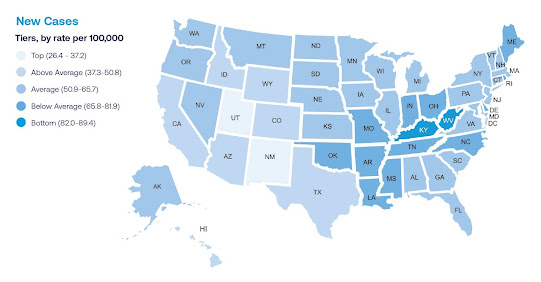Ky. ranks first in lung-cancer cases, and low in survival and early diagnosis, but prevention, screening and treatment are easier now

At 89 cases per 100,000 residents, Kentucky is No. 1 in the rate of new lung cancer cases. The national rate is 58. (Map from the American Lung Association 2021 State of Lung Cancer report)
—–
By Melissa Patrick
Kentucky Health News
Lung Cancer Awareness Month falls in November, but in Kentucky the promotion of prevention and early detection of lung cancer is needed all year because the state leads the nation in lung-cancer cases and has a death rate from the disease that is 50 percent higher than the national average.
A year-long multimedia campaign, led by the Kentucky Medical Association, the Kentucky Foundation for Medical Care and the Anthem Foundation, aims to do just that. The Breathe Better Kentucky campaign is designed to educate Kentuckians on lung-health issues and encourage them to schedule appointments to discuss any symptoms, risk factors, or screening tests that they might be eligible for.
“For patients who have small, early-stage lung cancer, early detection is critical to successful treatment, as the cure rate can be as high as 80 to 90 percent when caught in the beginning stages,” Dr. Neal Moser, Dr. Shawn Jones and Dr. Jeff Reynolds wrote in the Northern Kentucky Tribune.
Far too few Kentuckians know lung cancer has become easier to prevent, find and treat, Dr. Timothy Mullett, medical director of the University of Kentucky‘s Markey Cancer Center Affiliate & Research Network.
At a news conference about Lung Cancer Awareness Month, Mullett said he was frustrated about that, partly because “the burden of lung cancer on the people in Kentucky is unequaled.”
| American Lung Association graphic; for a larger version, click on it. |
The fourth annual American Lung Association State of Lung Cancer report places Kentucky among the worst five states for smoking, new cases, early diagnosis and survival.
The report ranks Kentucky second in screening, perhaps driven by its high case rate, but says it’s worse than average in the percentage of lung-cancer patients (19%) not receiving treatment. It ranks 18th for this measure.
The national rate for lack of treatment is 21%. The report adds that over the last five years, the percent of cases receiving no treatment in Kentucky increased by 10%.
One of the best ways to prevent lung cancer is to prevent it and that involves helping the 23.4% of smokers in Kentucky to quit. Smoking is the number one cause of lung cancer, causing about 90% of cases, according to the American Lung Association. Kentucky ranks 2nd in the nation for smoking, following behind West Virginia.
The state Department for Public Health offers a service called Quit Now Kentucky to help Kentuckians of all ages quit smoking. To learn more go to QuitNowKentucky.org, text QUITKY to 797979 or call 1-800-QUIT-NOW.
The only recommended screening test for lung cancer is low-dose computed tomography, also called a low-dose CT scan, according to the Centers for disease Control and Prevention.
Annual CT scans are recommended for adults ages 50 to 80 who have smoked at least 20 “pack-years” (a pack-year amounting to one pack of cigarettes a day for a year, or an equivalent amount, such as half a pack a day for two years) and either still smokes or has quit within the last 15 years.
 |
| Map shows potential of indoor radon accumulation; click to enlarge. |
The second leading cause of lung cancer is exposure to radon, an invisible gas that comes from bedrock. You cannot see, taste or smell it, so the only way to know the concentration of it in your home is to test for it. Concentrations of radon in and under homes are high in many parts of Kentucky.
Some local health departments, as well as the Kentucky Radon Program, offer free short-term radon test kits to Kentucky residents. If elevated levels of radon are detected, radon mitigation systems can be installed to reduce it.
It’s also important to know that there is an even higher risk of lung cancer for people who smoke and also have radon exposure. According to the UK College of Nursing, the lifetime risk of radon-induced lung cancer is 62 per 1,000 ever-smokers compared to seven per 1,000 never-smokers. Because of this, people who smoke or use vape products should smoke outside, says the college’s BREATHE (Bridging Research Efforts and Advocacy Toward Healthy Environments) project.
Other causes of lung cancer include exposure to certain hazardous chemicals, pollution, and genetics.
Symptoms of lung cancer are coughing that gets worse or doesn’t go away, chest pain, shortness of breath, wheezing, coughing up blood, feeling very tired all of the time or weight loss with no known cause, according to the CDC.